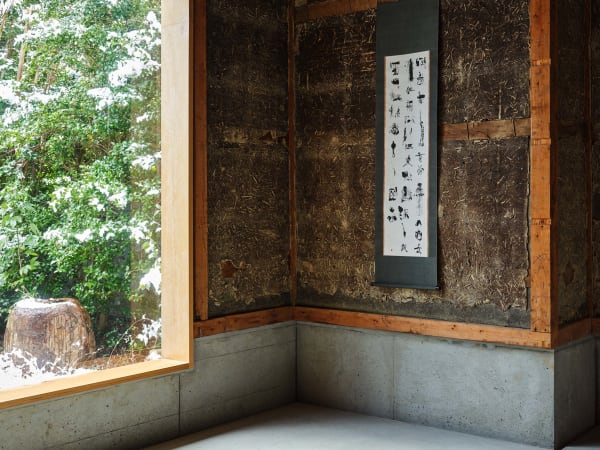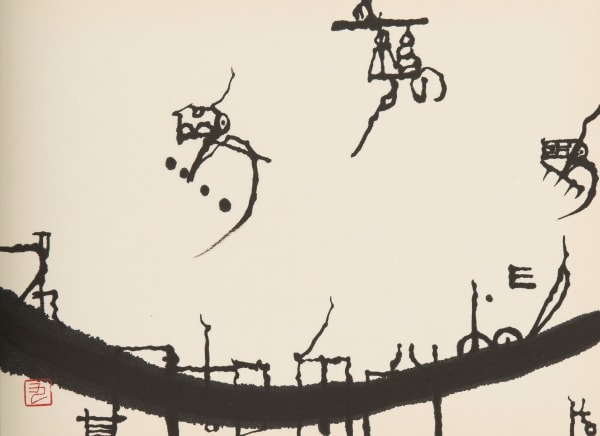-
Ishikawa Kyuyoh Exhibition
Shibunkaku
Part I April 18 − May 15, 2025
-
News
May 28, 2025
An article about Ishikawa Kyuyoh Exhibition was published on the art media platform Tokyo Art Beat.
書家・石川九楊展(京都・思文閣)を、アート、染織、茶の湯、食のクリエイターたちが鑑賞。孤高の世界を、それぞれの視点で観る ↗︎ [Available in Japanese only]
-
What is the most essential aspect of art that we need to preserve for future generations?
I believe it is originality—the remarkable gift that artists possess in abundance.
And originality, by all means, is something that the calligraphy of Ishikawa Kyuyoh exemplifies.
This spring, Shibunkaku is proud to host an exhibition focusing on the art of Ishikawa Kyuyoh, one of Japan's leading contemporary calligraphers.
Ishikawa Kyuyoh's works capture the essence embedded in words, drawing from the rich history cultivated in East Asia, and present it to us as a living expression. His calligraphy exudes a unique presence with its delicate yet overwhelming power. This exhibition is divided into two parts and is unprecedented in scale for our gallery.
Part I, starting from April 18, will feature representative works from the 1970s "Gray Era," as well as his monumental series Tale of Genji I, consisting of fifty-five full chapters, which challenged classical literature while rejecting established calligraphic sentiment.
Part II, beginning on May 17, will offer a comprehensive overview of Ishikawa Kyuyoh's representative works from each era, showcasing his artistic journey from the earliest creations to his latest masterpieces.
We warmly invite you to visit the exhibition and immerse yourself in the history and world of Ishikawa Kyuyoh's unique expression.
-
Travel, my child,
far from my hand, my brush.
Find love.
—On the occasion of the Shibunkaku Exhibition
Ishikawa Kyuyoh
I am honored to present an exhibition of my work at Japan’s leading art gallery, Shibunkaku, from April to June 2025.
My association with Shibunkaku is by no means a short one. In fact, Tanaka Shūji, the previous president of the Shibunkaku Group, visited my very first solo exhibition as an independent calligrapher, where I presented
a hundred works. The exhibition opened in Kyoto and later toured to Tokyo. The day before the opening, I finished hanging the works, but I was still waiting for one to arrive. I felt uneasy, because the display just didn’t feel right. I held my head in my hands, telling myself “It’s no good. It’s going to be a flop. It would have been better not to put on an exhibition at all.” But it was already too late to quit.
Taishō Mukei, a framed work, finally arrived at the venue the next morning. I quickly put it in place. The atmosphere instantly changed, and I knew that the exhibition would be a success. I breathed a sigh of relief.
It was Tanaka who bought Taishō Mukei. Years later, when I was coming up to forty, the age at which one is supposed to have no doubts, I approached him and said that I was thinking of putting out a proper monograph. He immediately agreed to take on the project, with the explanation, “I like your work.” That led to the publication of Ishikawa Kyuyoh sakuhinshū: Shikashi (Collected works of Ishikawa Kyuyoh: Yet…).
Later, I moved to Tokyo. After I lost my wife, who had been running a gallery specializing in calligraphy, the current president of the Shibunkaku Group, Dai Tanaka, contacted me in 2022 with the suggestion of publishing a catalog raisonn. and introducing my works to the world outside Japan. By that point, one of my books, Taction, had already been published in English and Chinese, and had gone through multiple print runs. (A translation of a second of my books into Chinese, and of another one into Korean are now in preparation, too.) Before then, I had rejected invitations to show at unnecessary or cursory exhibitions outside Japan, although I had taken up a few offers. But Tanaka’s proposal was not like the others. He was talking about a substantial, all-in effort. After a great deal of thought, I accepted. That decision resulted in the eventual publication, in 2024, of Complete Works of Ishikawa Kyuyoh as a three-volume set. My works apparently attracted a great deal of attention at presentations in Art Basel Hong Kong and at Frieze Masters in London, and I hear that they were very well received. Many visitors were curious about what was written in the calligraphy, which contrasts with the way that postwar avant-garde calligraphy had been evaluated—much like action painting and abstract art—according to how close it felt to “real” art. I was delighted to hear that people were interested in the contemporary nature of calligraphy as a form of expression distinct to East Asia.
I very much hope that this exhibition will be able to stand up to stringent examination by discerning collectors, and go on to gain their support, with works attaining broader recognition around the world and eventually being loved.
-
-
-
-
-
-
-
Installation
-
Biography
Ishikawa Kyuyoh
Calligrapher
Born in Fukui Prefecture, Japan in 1945. Graduated from the Faculty of Law at Kyoto University. After serving as a professor at Kyoto Seika University and the director of the Institute for Writing and Civilizations, he is now an emeritus professor at the same university. Ishikawa has elucidated the concept that “calligraphy is the art of hisshoku (taction),” and interprets the structure and history of calligraphy. As a critic, he is also active in discussions on the Japanese language and culture, which have had a significant impact across various fields. In both his artistic creations and written works, Ishikawa continues to produce cutting-edge expressions and insights. His body of work includes over 2,000 calligraphic pieces and more than 100 published books.
More About Ishikawa Kyuyoh
-
Journal
Ishikawa Kyuyoh Exhibition
Forthcoming exhibition
























